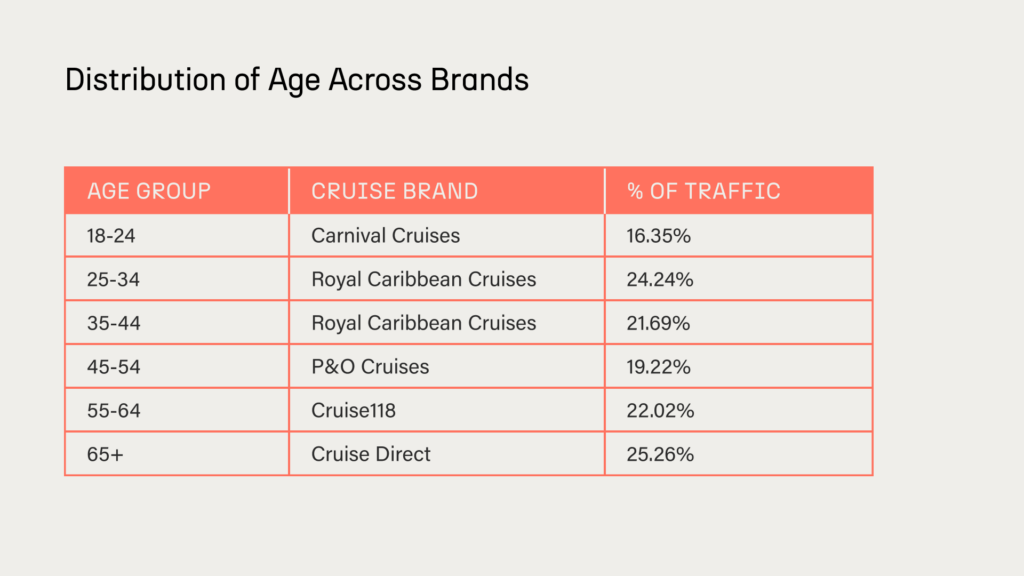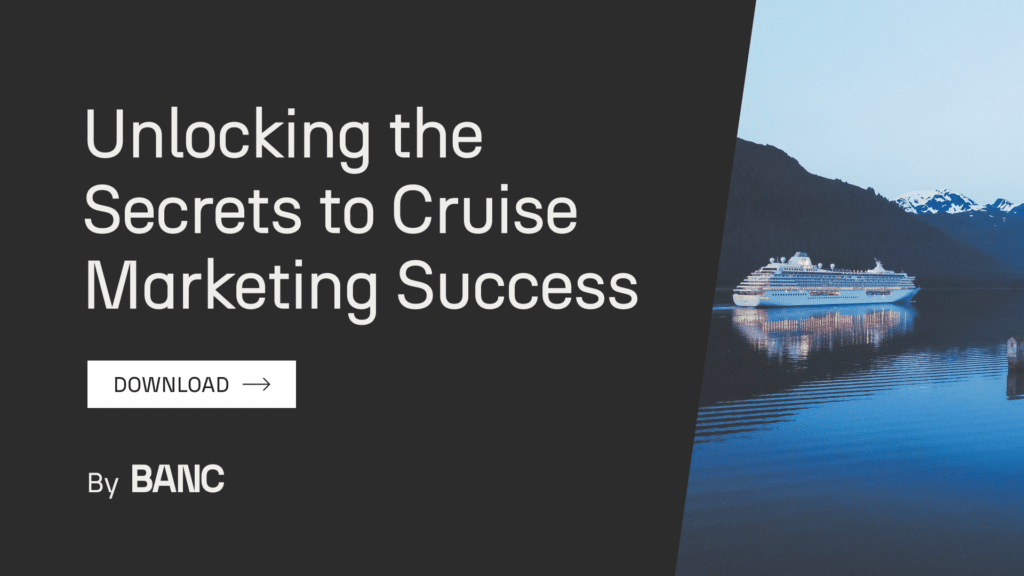Discovering Cruise Industry Audience Ages
Ask a group of people to think of a cruise holiday, and we’re pretty sure the vast majority would picture a similar image in their heads – especially when it comes to clientele. Let’s just say they’re probably of a ‘vintage’ year, right?
But is this view of the people who flock to the top deck necessarily true? Or is it just a bit of a stereotype? We’ll take a look into the matter below…
Quick Links
- A bit of background on our cruise research
- The ‘classic’ cruise industry customer
- The findings from our research
- The importance of knowing your audience
- Download our cruise industry marketing and trends research document
A bit of background on our cruise research
In all the time we’ve been working with brands, a good deal of it has been spent working with cruise businesses in some form or other. By understanding what makes them tick and creating performance-boosting digital strategies, the knowledge we’ve built up gives us the perfect foundation to carry out a bit of research into the area.
Researched, written up and now fully assembled, our cruise research paper is a detailed look at the cruise industry’s digital marketing that readers can use to improve their own approaches. Part of this research includes investigating demographic information from across the industry’s audience, which we’ll delve into now.
The ‘classic’ cruise industry customer
The stereotypical view of cruise customers tends to be that they’re old or retired. And sure, on smaller ships that are on the pricier side, you’ll usually find passengers that fit this bill more than usual. However, the truth is that there’s really no such thing as the ‘typical’ cruise passenger. Cruise customers are made up of a range of ages, backgrounds, interests, and economic statuses.
The findings from our research
Traffic distribution across age groups
From our research, we found that traffic distribution was split across age brackets in the following ways…

Further analysis
So, let’s unpack the above a bit more. Sure, the majority of traffic overall is driven by 55–64-year-olds, confirming that the priority target audience for the cruise industry is very much the ‘older’ generation. But before you say, “we told you so”, there are some interesting things to note too.
Traffic from the 25-54 age group and the 65+ age group are at very similar levels. And while the 18-24 age range had only 9% traffic, we saw that younger age groups amassed large amounts of traffic searching for specific cruise lines. This suggests that the younger age groups are seeking out specific cruise lines, routes, and ships, whereas older generations are more willing to shop around for the best cruise deal.

Other noteworthy stats from our research include:
- Carnival Cruises had the highest percentage of 18–24-year-olds driving traffic, at 16.35%
- Royal Caribbean Cruises had the highest percentage of 25–34-year-olds driving traffic, at 24.24% and the highest percentage of 35–44-year-olds driving traffic, at 21.69%
- P&O Cruises had the highest percentage of 45–54-year-olds driving traffic, at 19.22%
- Cruise118 had the highest percentage of 55–64-year-olds driving traffic, at 22.02%
- Cruise Direct had the highest percentage of 65+ year olds driving traffic, at 25.26%
What conclusions can we draw?
Our data confirms that 55–64-year-olds are the age group that holds the highest share of audience traffic in the cruise industry. However, it doesn’t conform to the idea that cruises are for the retired community. Likewise, all other age groups aside from the 18-24 group had a similar level of traffic (only a difference of ~2%) showing that cruises are, somewhat surprisingly, popular across the 25+ age groups. Will the young people cruise audience be a segment we’ll see more and more brands catering to in the not-too-distant future?
The importance of knowing your audience
Knowing your audience is vital. If you don’t know who they are, what they like and what they’re looking for, then you’ll have very little information to base your marketing activities around – which will render all your efforts a bit, well, random.
With this information, however, you’ll give your strategies and content laser focus. When it’s relevant and targeted, your content and activities will resonate with your audience. Knowing who your audience is also helps with measuring the success of your campaigns, which you can then use to tweak and optimise future content – and ensure greater effectiveness too.
Don’t leave things up to chance. Get to know your digital marketing audience effectively and properly. We’ll show you how here.
Marketing to different ages
It’s rare that a brand only appeals to one demographic of people. Marketing, age groups and branding all intersect in various ways, and when it’s done right, the effects can be powerful. So, who should you be paying attention to, and how can you make sure your activity appeals to them? Let’s look at some of the broader age groups…
Baby Boomers
Who?
Financially stable, and possibly retired, Baby Boomers have more disposable income than any other generation. With all that free time, they’re spending more time online too.
How to appeal to them
- Use email marketing as a primary channel
- Foster trust and value through testimonials, reviews, and case studies
- Market yourself through social media – Baby Boomers are becoming more and more adept at it
Generation X
Who?
Born between 1961 and 1981, Gen Xers have a degree of economic stability and are more used to social media than their predecessors, but are busy with work and family responsibilities.
How to appeal to them
- Gen X has seen it all. They’re just as comfortable with traditional marketing as they are the digital variety. Reach them through TV and print ads, alongside email, social media, and video content
- Make their lives easier. Offer choices like free transfers and different payment methods that take the pressure off their daily schedules
- Connect to their inherent nostalgia and authenticity through marketing fused with pop culture, humour and storytelling
Millennials
Millennials have had the best of both worlds: analogue and digital. Born between 1975 and 1995, they’re media and tech-savvy, and they’ve had time to get used to every emerging technology that’s gone to market.
How to appeal to them
- Use social media as a primary channel
- Provide value and entertainment through engaging content, interactive features, gamification and user-generated content
- Be open and authentic in your activity. Millennials don’t suffer fools gladly; they know when brands aren’t being genuine. Focus campaigns on real people with real stories
Download our cruise industry marketing and trends research document
To check out our cruise industry research paper in full, be sure to grab it here.

Not sure where to start with your strategy? Let us take a look instead! We’ll shape up an approach that connects marketing activity to company goals – a solution that translates to real commercial growth. For more information, head to the homepage or give us a call on 0345 459 0558.



